Wallflowers: Reimagining Historical Interiors
By Anna Rowe, 2025 Digital collections catalyst | 17 June 2025
Guest blogger: Anna Rowe - 2025 Digital collections catalyst
Interiors are the spaces we inhabit – where we live, work, gather, learn and play. Their design and decoration reflect aesthetic, social, personal, functional and financial considerations – both now and in the past.
As an archaeologist and an interior designer, I am fascinated by photographs of historical interiors. They capture not only the styles and materials of their time, but also individual tastes, aspirations and everyday life for past generations. I love zooming into the details. I am intrigued by the wallpapers and other patterned finishes that are sometimes hiding in the background. What inspired them and how were they composed? What were their original colours and how would they look using various palettes?
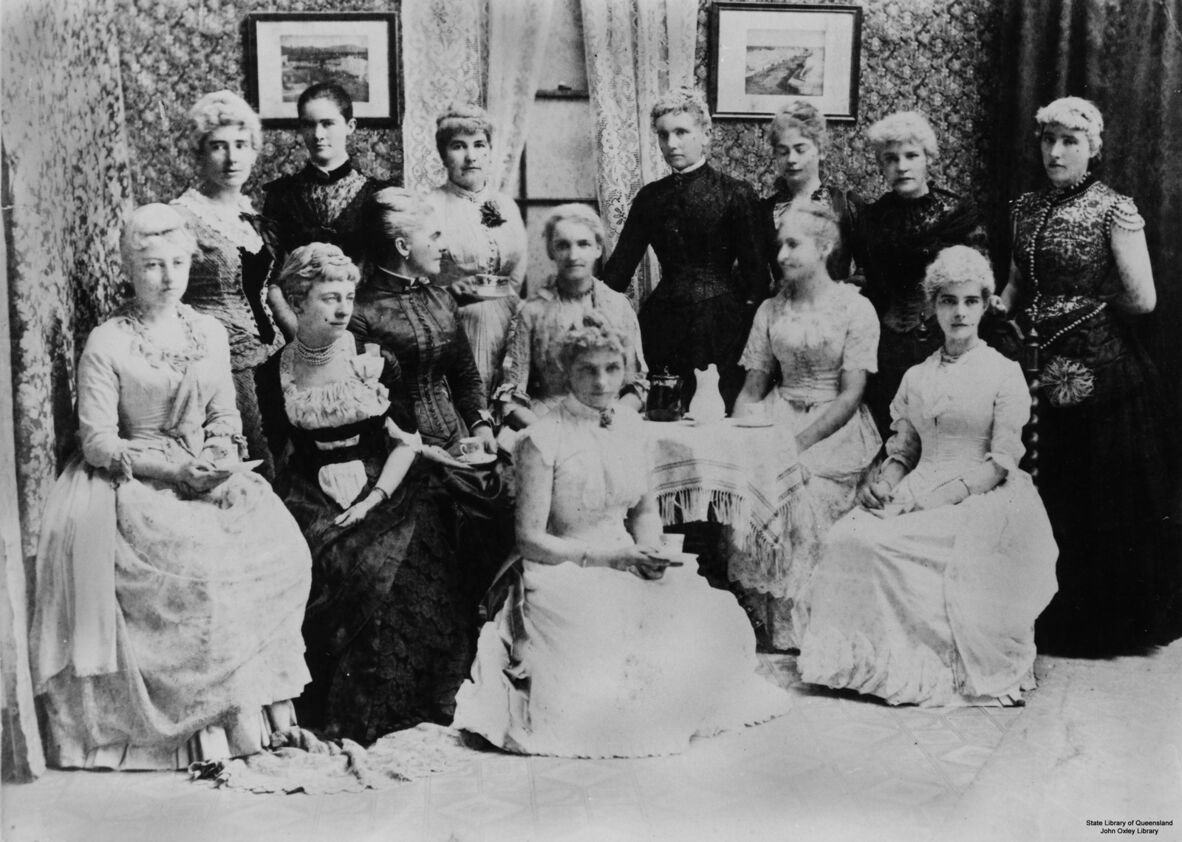
Portrait of a group of ladies at a tea party, Charters Towers, ca. 1880-1890. John Oxley Library, State Library of Queensland. Negative number: 71744. (1)
‘Wallflowers: Reimagining Historical Interiors’ explores these questions and more using digitised photographs of late nineteenth and early twentieth century interiors from the John Oxley Library collection. These black and white images are a valuable record of past decorative schemes in Queensland, offering a glimpse of social and private spaces that have been invariably lost to time. This project will investigate both the obvious and the obscure of these images – research and visualise them in colour and delve deeper into their decorative elements to create an interactive digital experience.
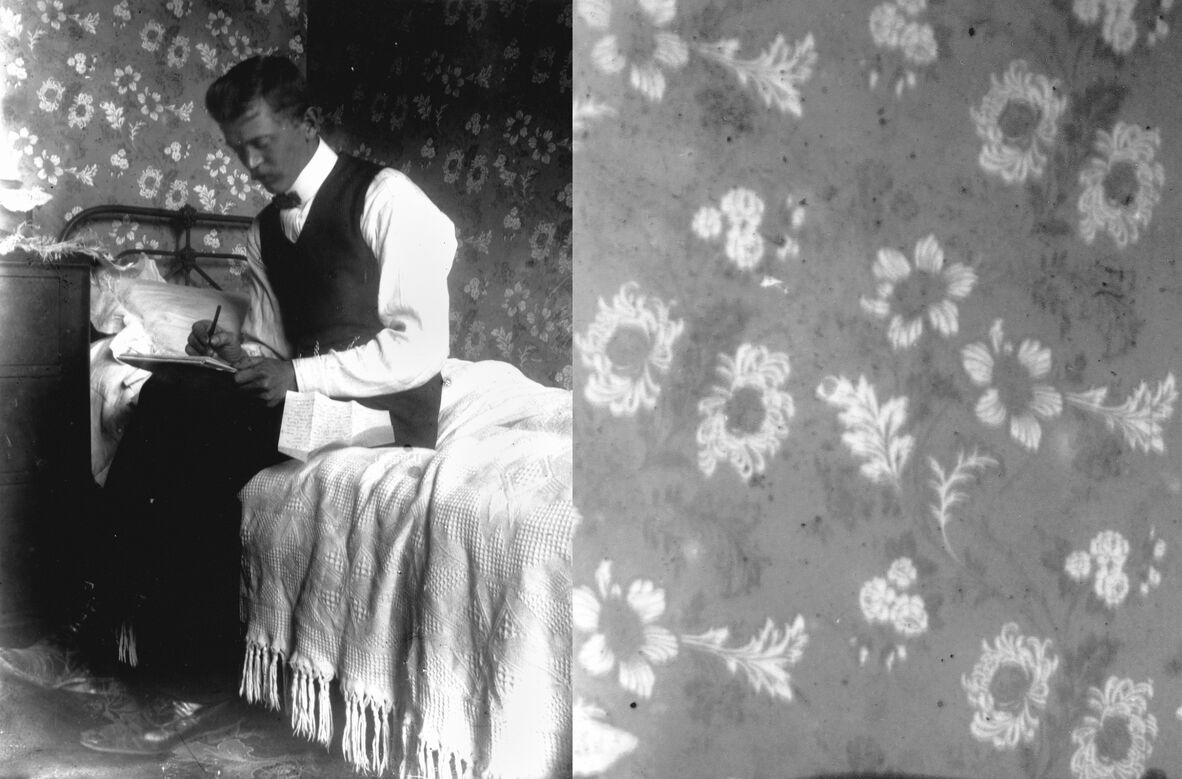
Intimate portrait of a man writing a letter, ca. 1900-1910. John Oxley Library, State Library of Queensland. Negative number: 175036. (2)
Queensland interiors – setting the scene
The photographs of historical interiors held in the John Oxley Library collection vary in composition, content, and quality. Some include their occupants. Some are informal while others are staged expressions of taste and propriety. Each photograph tells a story and collectively they illustrate some of the interesting ways Queenslanders engaged with and interpreted the broader influences, practices and materials of their time.

Eileen, Marjorie and Allan Row reading inside their home at the Dunwich Benevolent Asylum, ca. 1906-1914. 33383, Mark Wilson glass plate and photographic negatives collection. John Oxley Library, State Library of Queensland. Image number: 33383-0002-0091. (3) The room features a floral frieze and mouldings picked out in contrasting paint colours.
During the late 1800s and early 1900s, interiors in Australia typically featured decorative finishes and ornamentation – from the rich and complex schemes of the mid to late Victorian periods, to the milder and more stylised schemes of the Edwardian period. (4) Great care was taken in the selection and placement of these embellishments, guided by theorists of the day and advice manuals on how to tastefully decorate and run one’s household. (5)
A hierarchy of decoration was applied to various rooms in the house. Emphasis was placed on public spaces, including the entrance hall, drawing room and dining room, while private spaces received simpler treatment. (6) Walls were often divided into three zones – the lower dado, the middle body or filling, and the upper frieze – defined and decorated using paint, stencilling, wallpaper or timber detailing. The dominance and finish of each zone varied over time. (7)
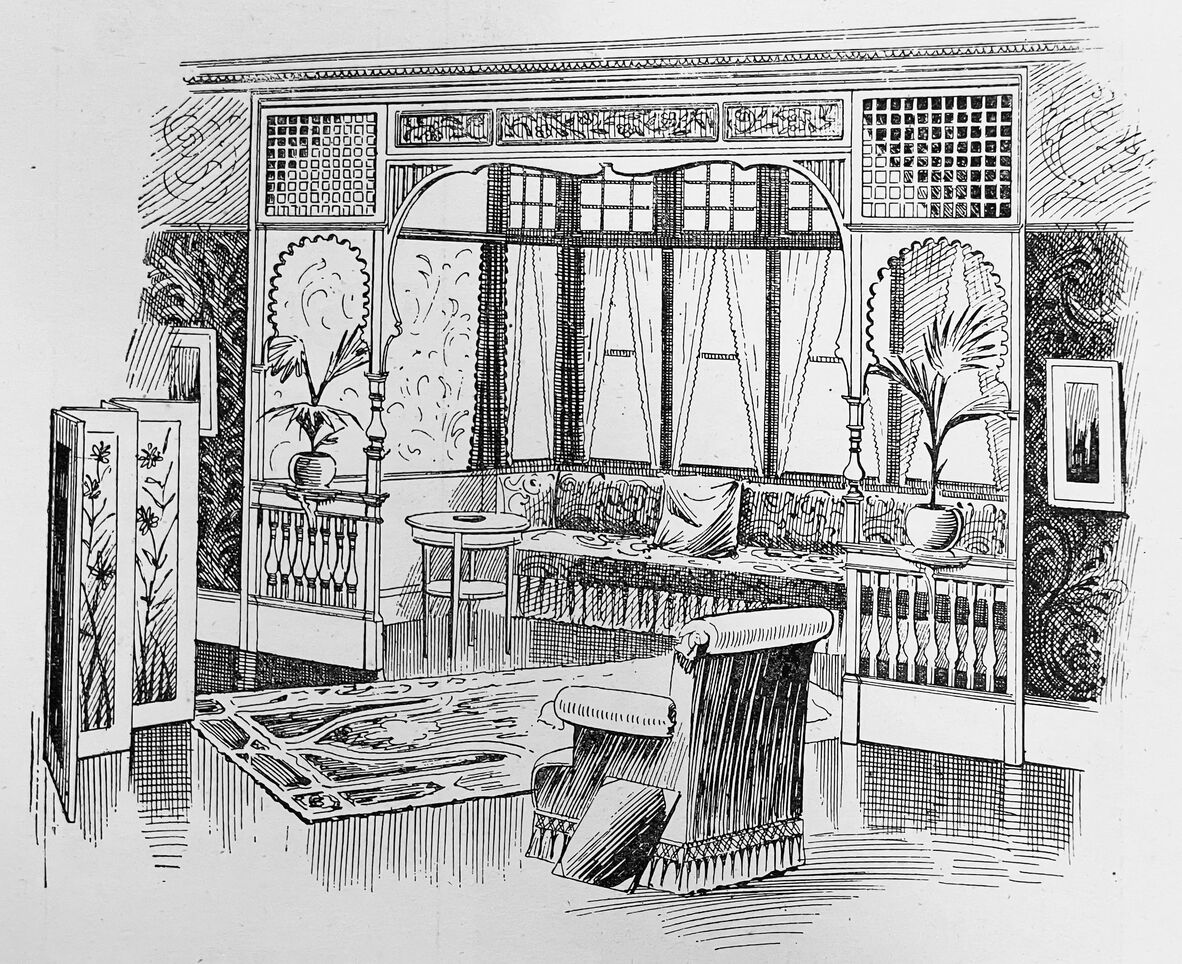
Illustration of a decorative scheme for a Drawing Room, from XXth Century Cookery and Home Decoration, 1900. John Oxley Library, State Library of Queensland. (8)
Compared with schemes in the southern States, and the international models that influenced them, decorative finishes were deployed relatively sparingly in Queensland. (9) Reasons varied across the State and included access to relevant trades, adaptations made in response to the climate and distinct built environment, and individual tastes and budgets. (10)
Timber was readily available and widely used in Queensland. Many houses had walls and ceilings lined with tongue-and-groove timber boards – initially beaded and later V-jointed (VJ). Some interiors were unpainted and finished with a shellac or oil finish. (11) Some interiors were painted, with mouldings such as skirtings, picture rails and cornices, along with panels on doors, picked out in different colours to the main walls. (12) Stencilling was used to decorate both painted and unpainted rooms.
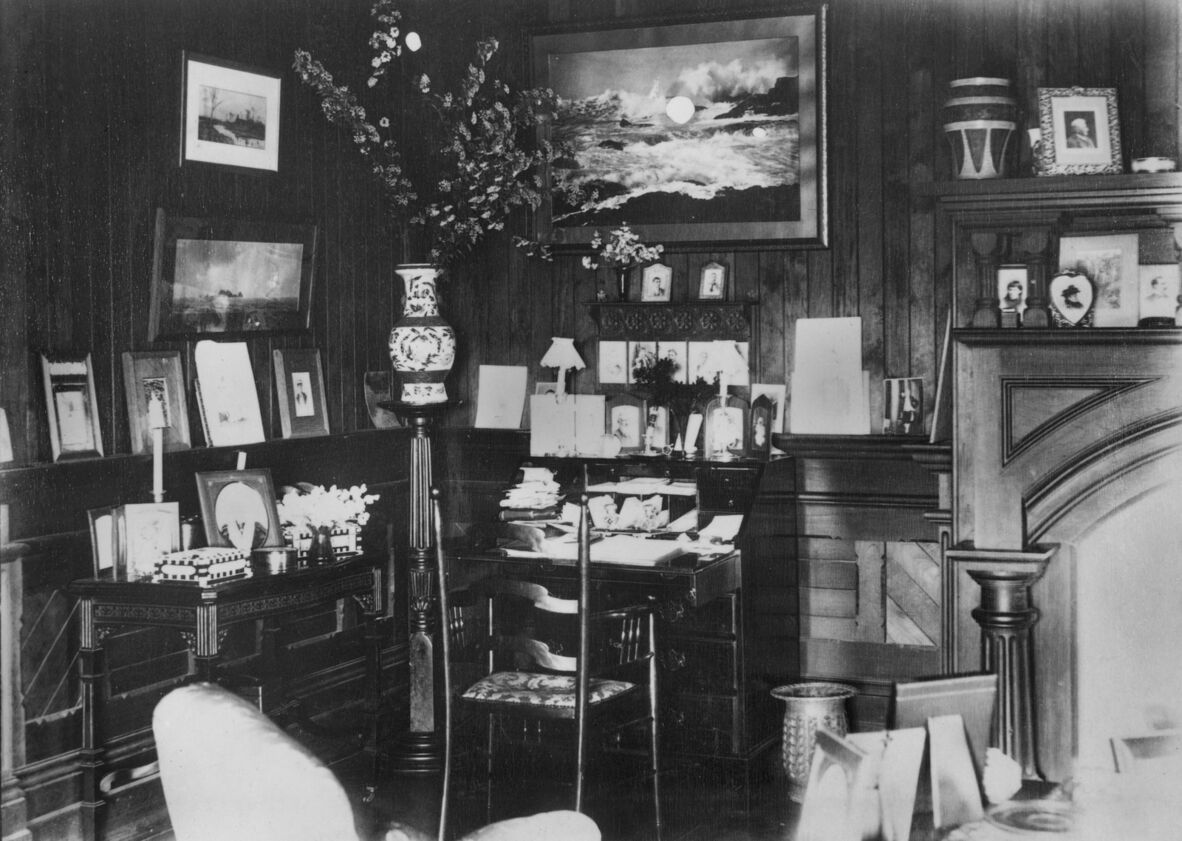
Drawing room at Harrow, on the Darling Downs, ca. 1885. John Oxley Library, State Library of Queensland. Negative number: 16178. (13) The timber walls are unpainted, and a dado is formed using mouldings and inlaid boards.
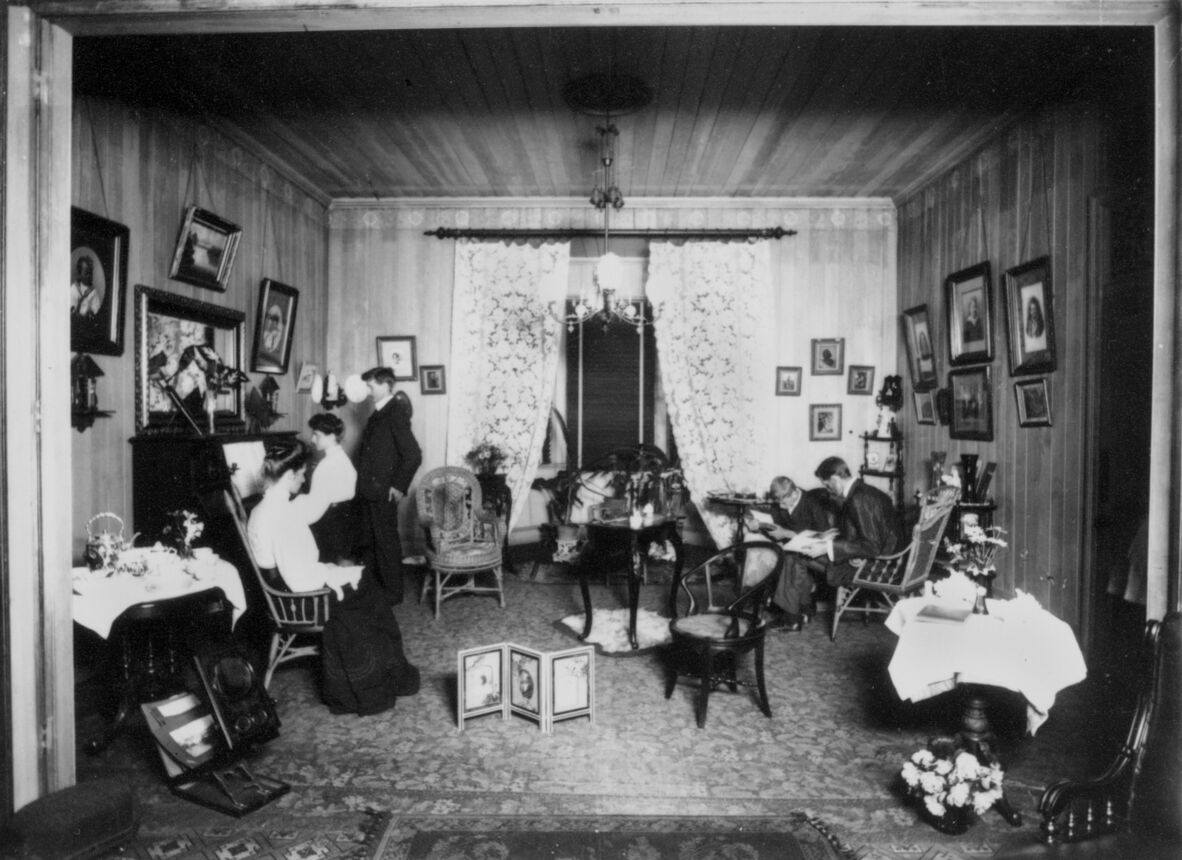
Living room of the Poulsen family home, ca. 1910. John Oxley Library, State Library of Queensland. Negative number: 123083. (14) The timber walls appear to be unpainted and feature a stenciled frieze.
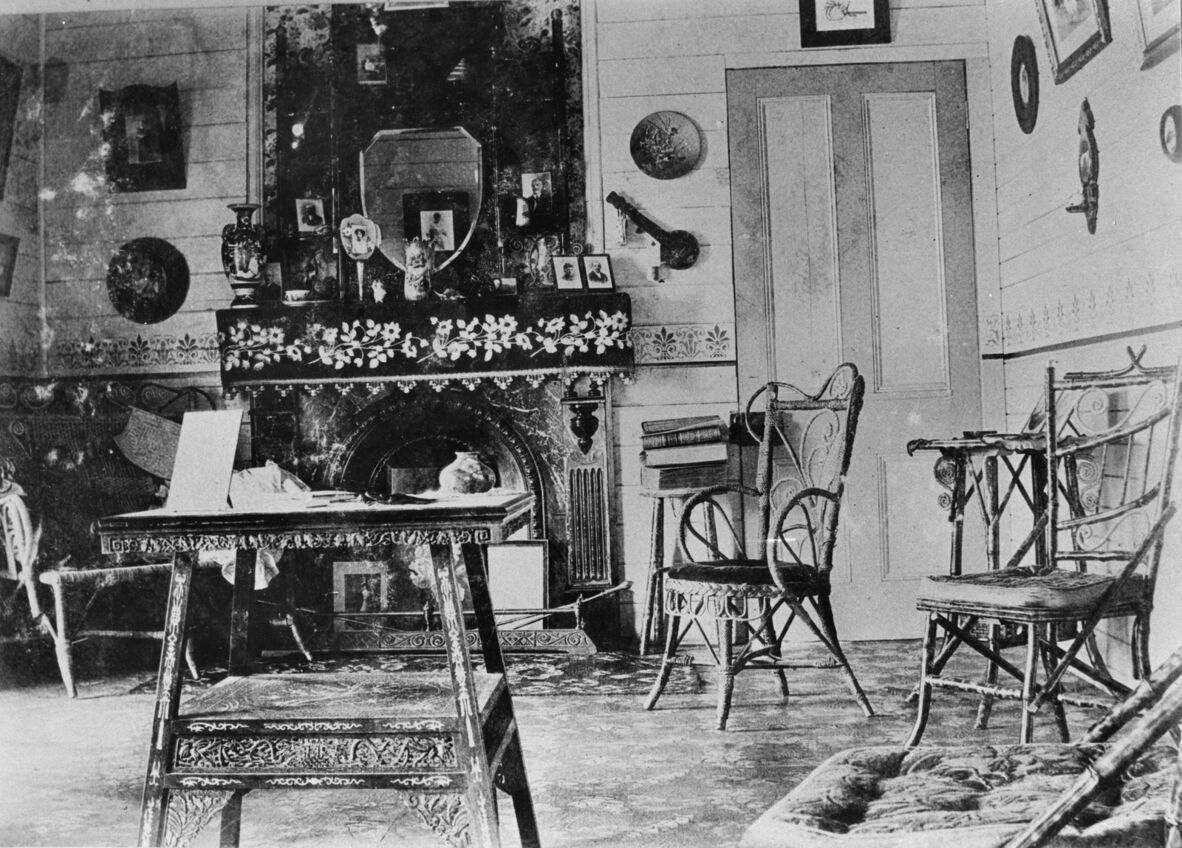
Interior view of the sitting room of a home in Clayfield, Brisbane, ca. 1915. John Oxley Library, State Library of Queensland. Negative number: 35265. Dunoon, a home belonging to JJ and AS Trundle, was built in 1885. The stenciled dado would have been considered a bit old fashioned when photographed in ca. 1915. (15)
Wallpaper was used in both masonry and timber houses in Queensland. To overcome uneven surfaces, it was sometimes glued to a calico or hessian lining or ‘scrim’ and tacked over the timber boards. (16) Wallpaper patterns featured floral and other botanical motifs, which were increasingly stylised around the turn of the century.
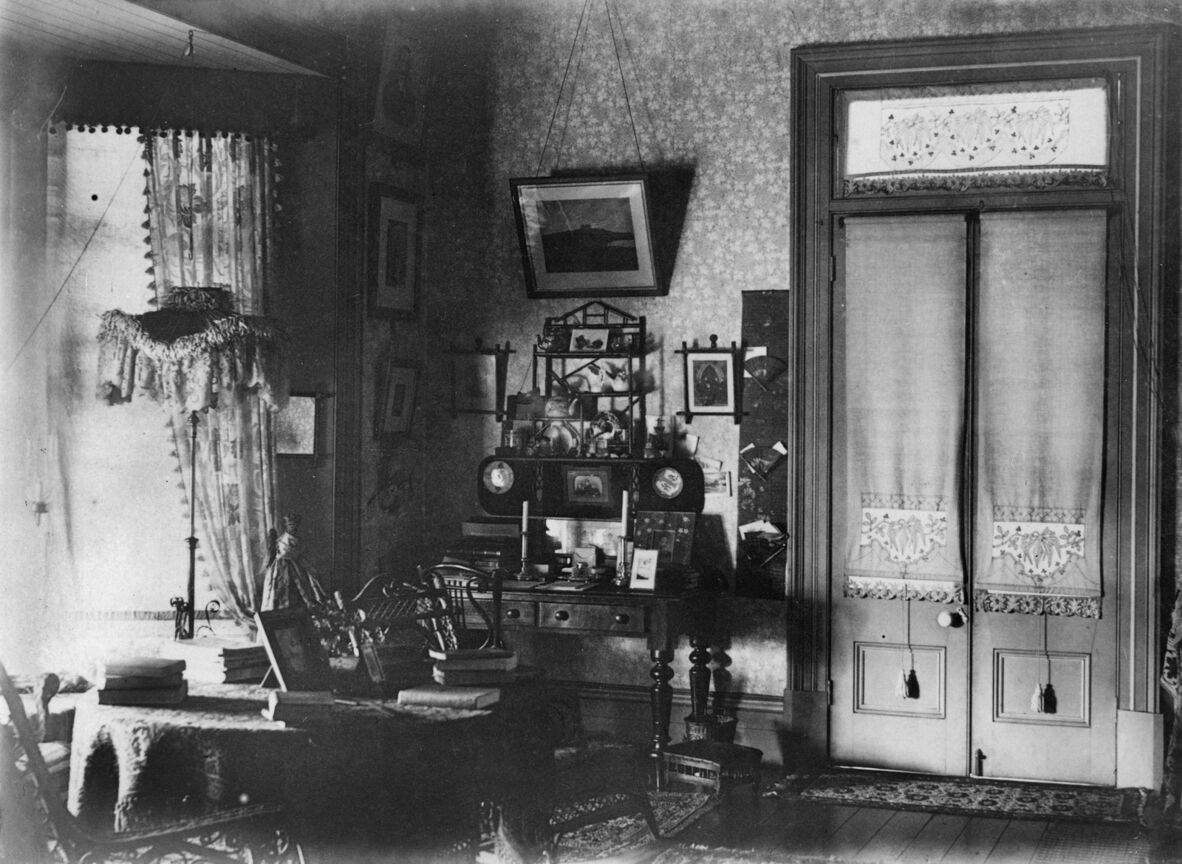
Early example of interior decoration, Queensland, ca. 1885. John Oxley Library, State Library of Queensland. Negative number: 16176. Note this interior is likely from Fairseat, Torwood (now Bardon), Brisbane, home of the Hume family in the 1890s. (17)
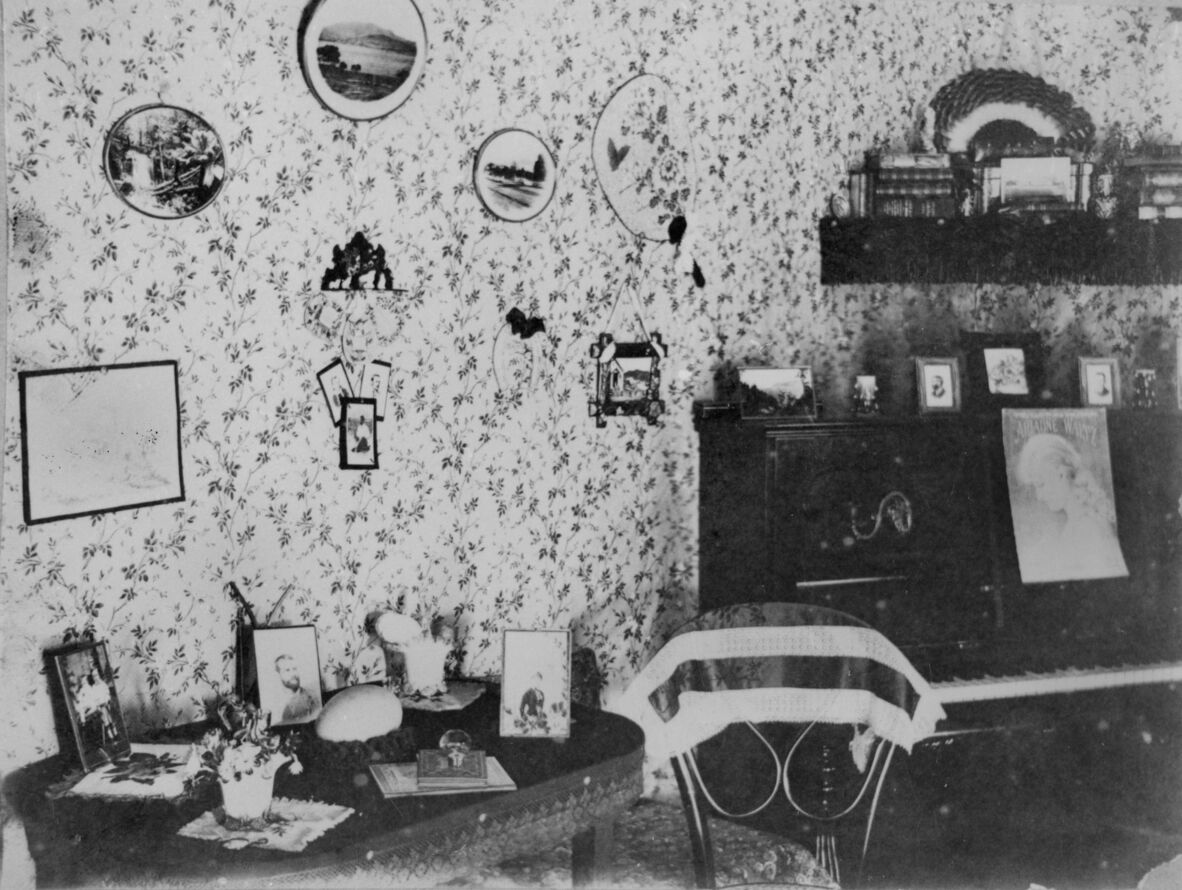
Wallpaper is prominent in this drawing room, ca. 1888. GS-39 Owen Livingstone Amos Photograph Albums. John Oxley Library, State Library of Queensland. Negative number: 76362. (18)
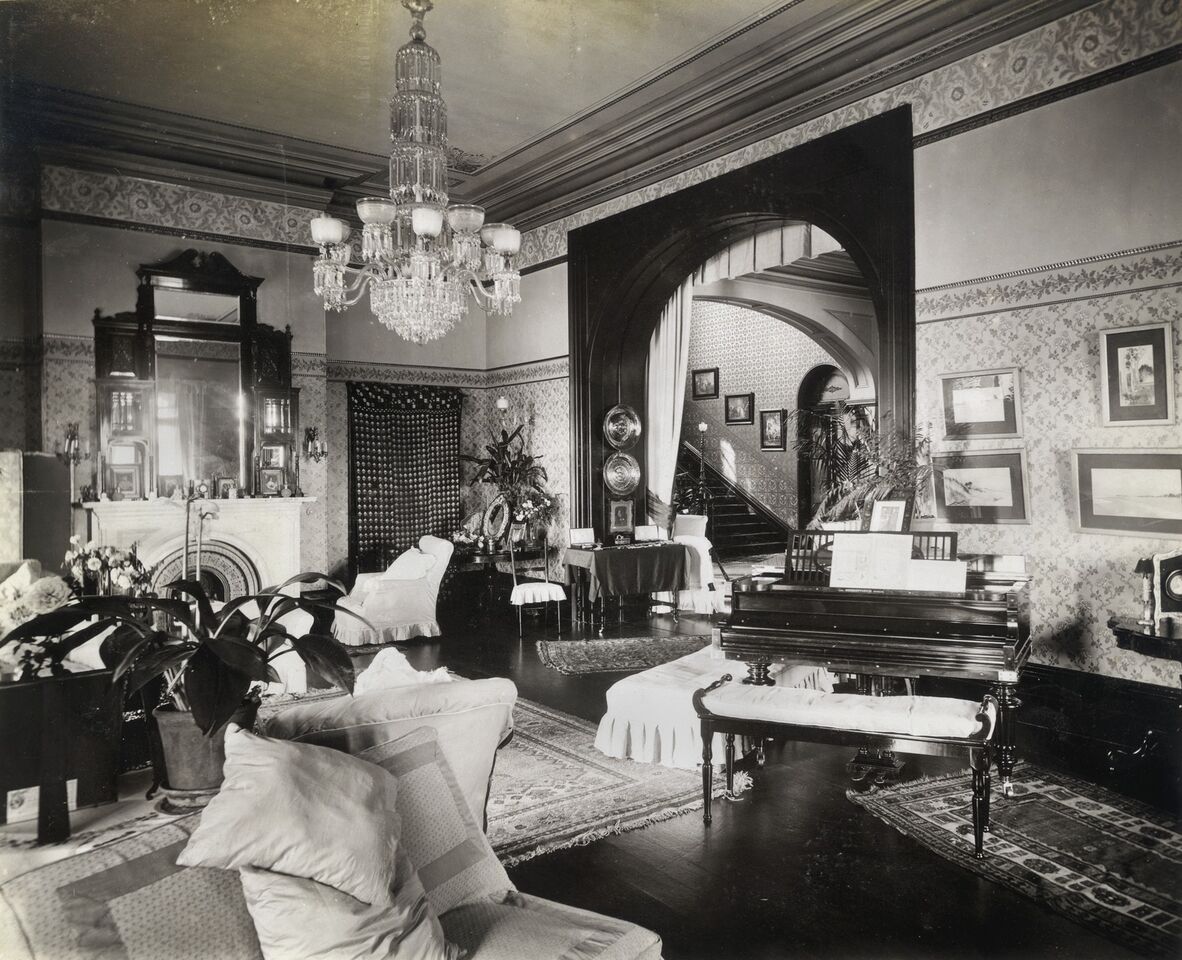
Drawing room at Government House, Brisbane, October 1907. APO-28 Chelmsford Photograph Album. John Oxley Library, State Library of Queensland. Image number: APO-028-01-0008. (19)
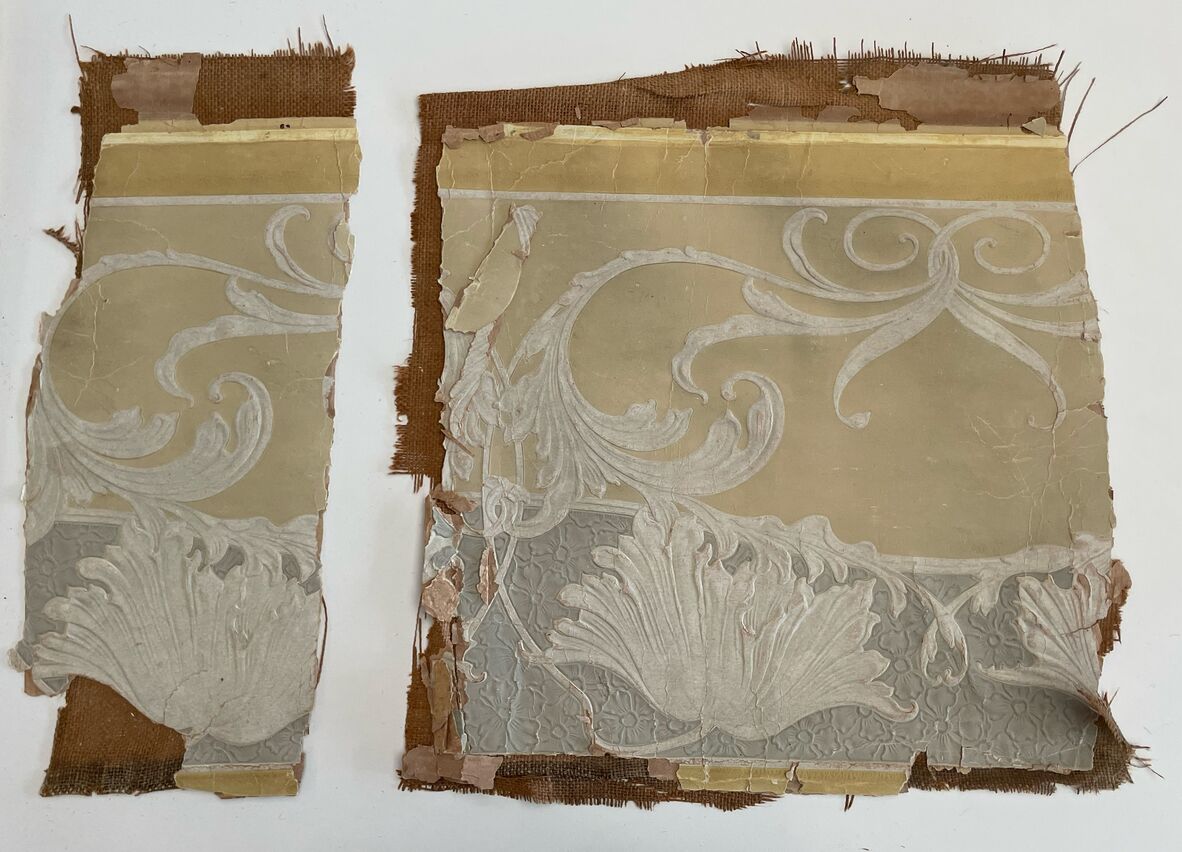
Sample of wallpaper on hessian backing, part of Robin Dods frieze paper from dining room, Ralahyne, Enderley Road, Clayfield. Professional and business archive of Allom Lovell Architects. John Oxley Library, State Library of Queensland. Accession number 28652, Item 1577. (20)
Pattern and ornament weren’t just applied to the walls. Ceilings in main rooms sometimes featured decorative plaster roses and cornices or were stencilled or lined with pressed metal. (21) Timber floors were layered with patterned linoleum, oilcloths, floorcloths, fibre matting, carpet and rugs. (22)

Ornately decorated sitting room, date unknown. 30586 Mrs. Annie Margaret Wheeler papers 1884-1991. John Oxley Library, State Library of Queensland. Image number: 30586-0001-0042. (23)
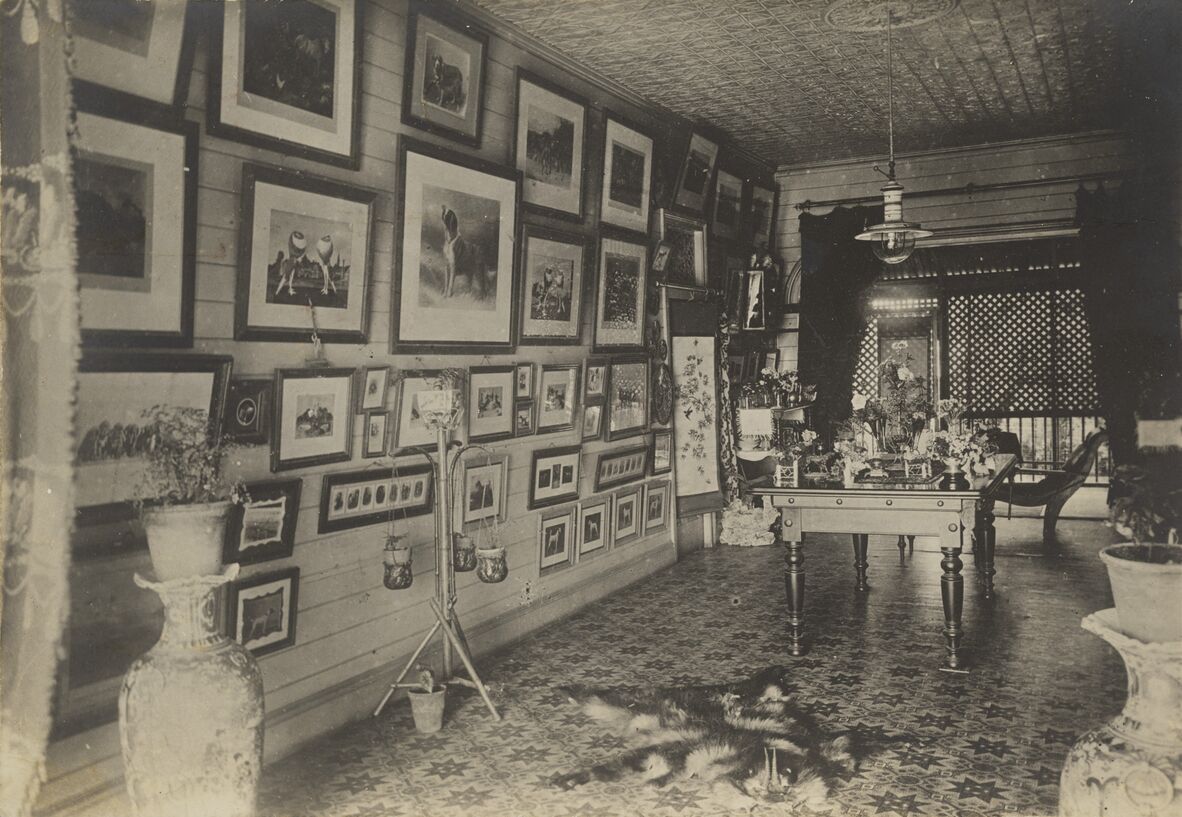
Photograph of the interior of Bobstay Cottage, Charters Towers, 1908. John Oxley Library, State Library of Queensland. Accession number: 33904. (24)
Queensland’s warm climate encouraged a relatively light and airy interior aesthetic. Windows and French doors were furnished with lace, muslin and floral curtains and blinds. Lattice panels and slatted timber blinds filtered the light. Rooms were filled with an eclectic mix of upholstered, bentwood and cane chairs, framed pictures and assorted objects that reflected their owners’ interests and personality, along with potted plants – both indoors and in furnished verandahs. (25)
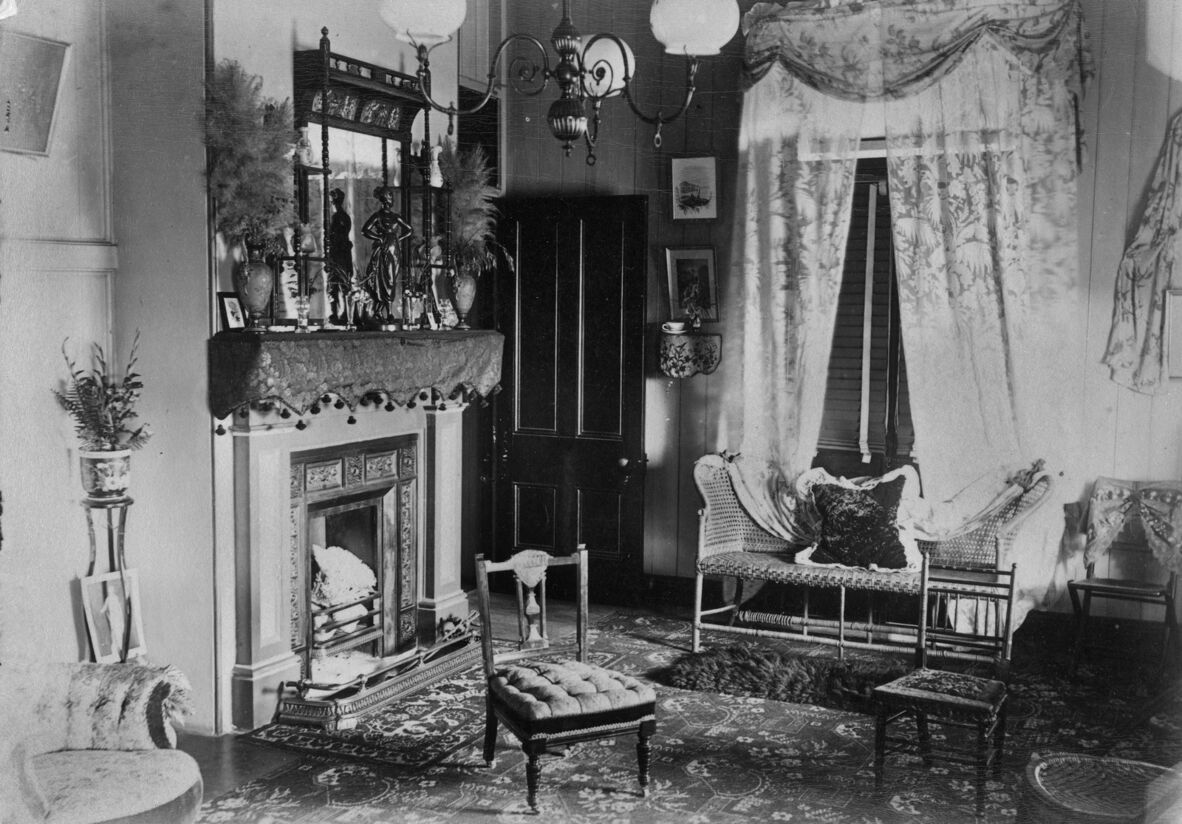
Interior view of a sitting room, Queensland, ca. 1895. John Oxley Library, State Library of Queensland. Negative number: 8710. (26)
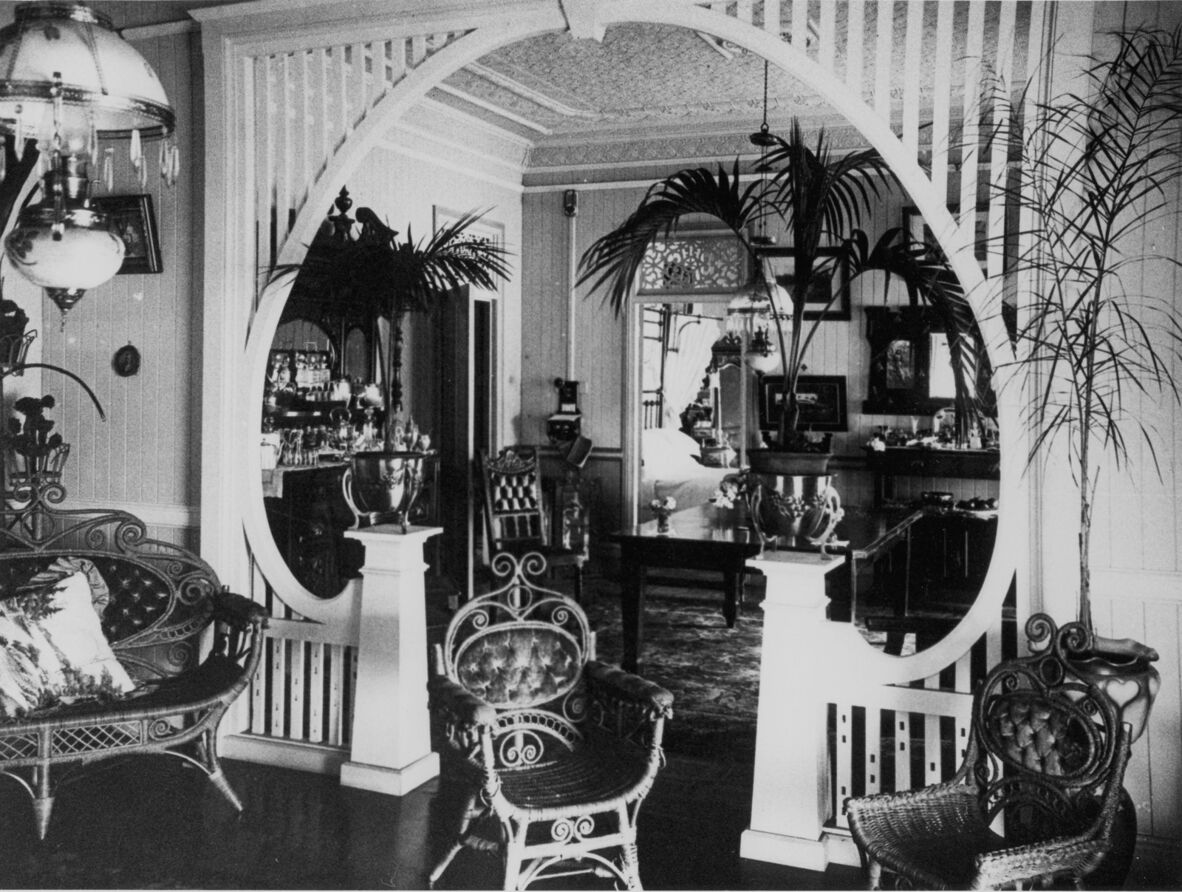
Interior of Mimosa, Hawthorne, ca. 1913. J.W. Fegan. John Oxley Library, State Library of Queensland. Negative number: 62782. (27)
The humblest dwelling could be elevated with the use of decorative finishes and furnishings. Advancements in technology and manufacturing meant wallpapers, textiles and floorcoverings became increasingly available and affordable for Queensland’s expanding population. In remote and transient communities, such as those associated with mining and railway construction, floral and other embellishments helped create a sense of home.

Family portrait taken inside a tent, Mt. Garnet, North Queensland, ca. 1905. John Oxley Library, State Library of Queensland. Negative number: 13101. (28)
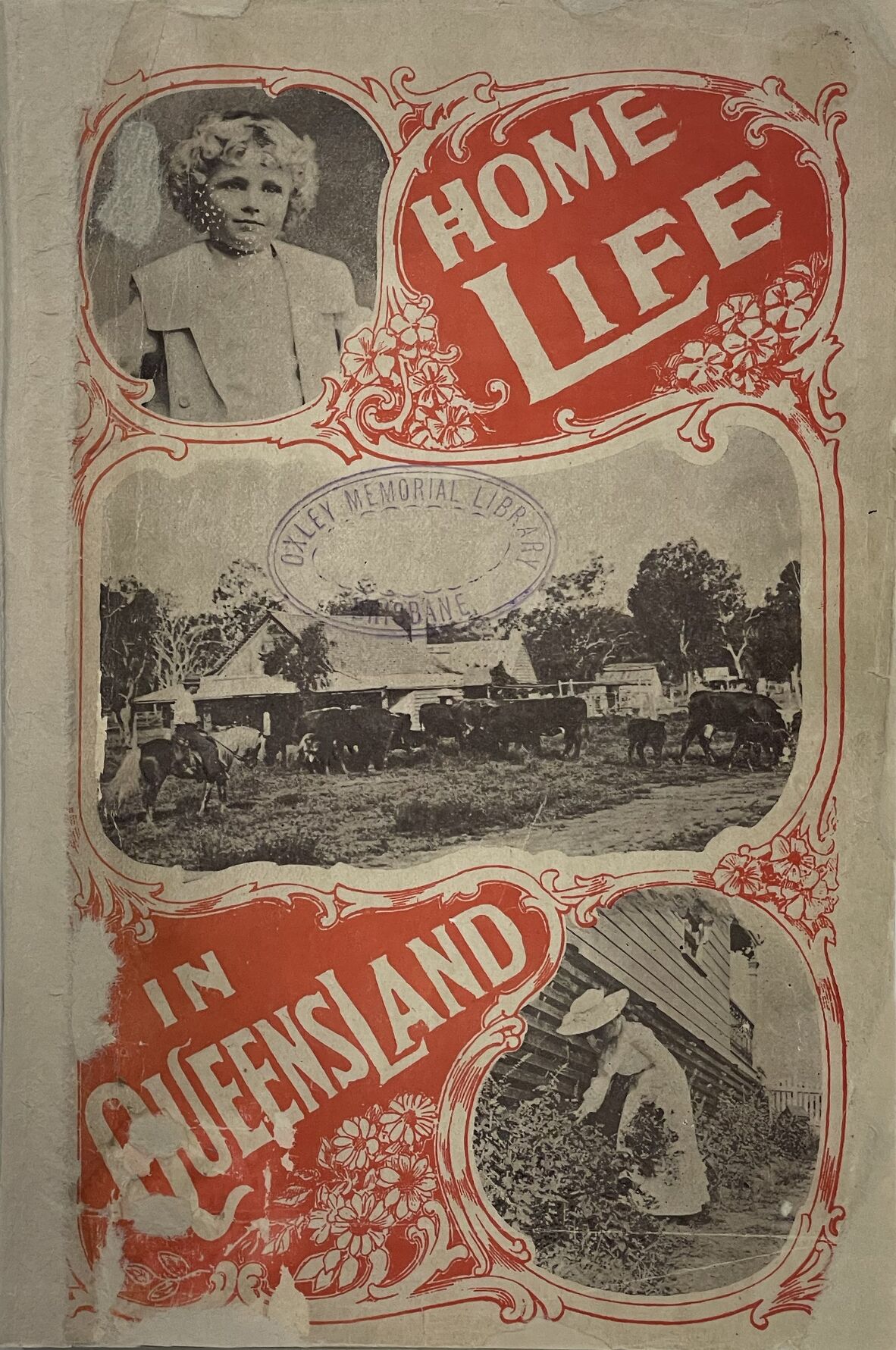
Queensland at Home, 1905. A.D. Graham and Queensland Department of Agriculture. John Oxley Library, State Library of Queensland. (29)
The conversion of the bare boards of the building into a home is of course, a matter of the taste and abilities, pecuniary or otherwise, of the occupier. Of house furnishers there is no lack in Queensland, and their warehouses teem with goods intended to meet the wants – and purses – of purchasers of differing capacities.
Decorative schemes were not confined to the domestic sphere. Cafes, hotels and other businesses featured wallpaper and linoleum in their interiors. Plenty of visual distraction could be found in the dental surgery of A.J. Moorhouse in Queen Street, Brisbane, which featured strong geometric patterns on the walls and floors.
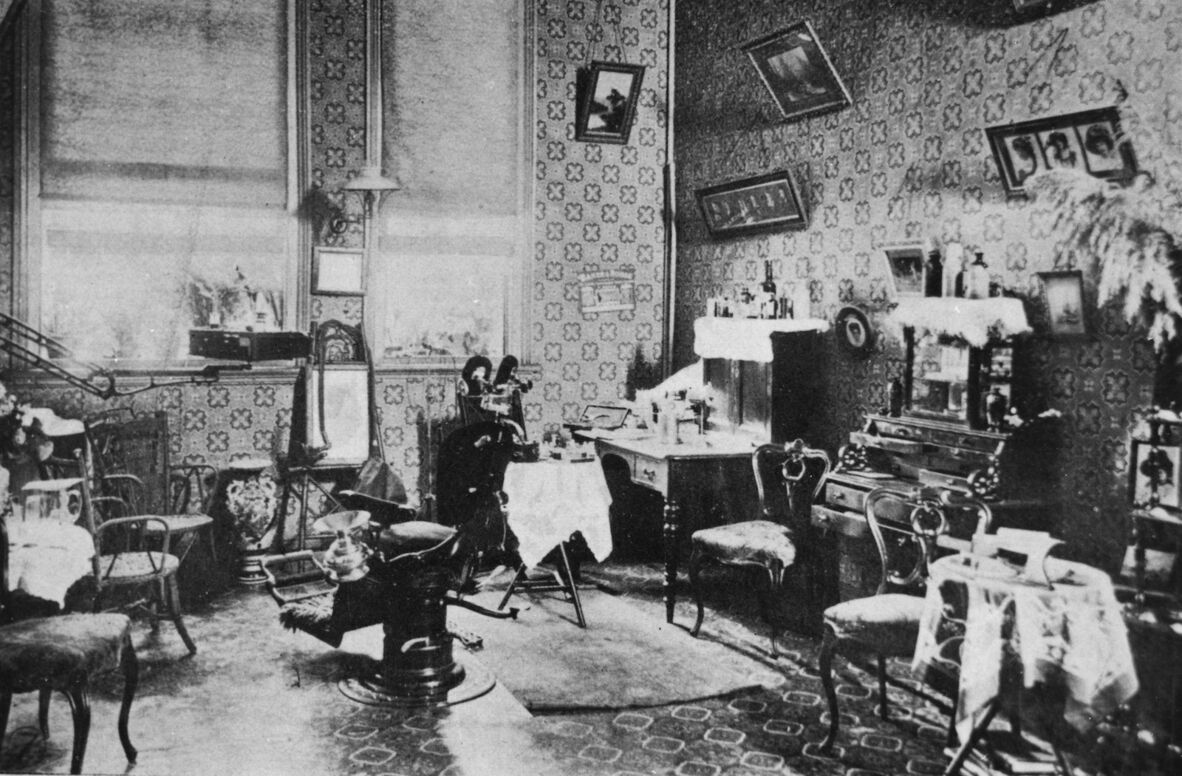
Interior view of A.J. Moorhouse's dental surgery Queen Street, Brisbane, 1909. John Oxley Library, State Library of Queensland. Negative number: 120394. (30)
Investigating interiors – reading the room
Interiors are a relatively ephemeral aspect of our built heritage. Over time, as occupants and trends come and go, original and early decorative schemes are replaced and rarely survive intact.
Photographs of historical interiors are a rare and important resource. They can capture complete decorative schemes at a point in time. However, their absence of colour is a limiting factor. The tonality of the images offers a clue to the relative light, medium and dark qualities of decorative elements, but the colours remain open to interpretation.
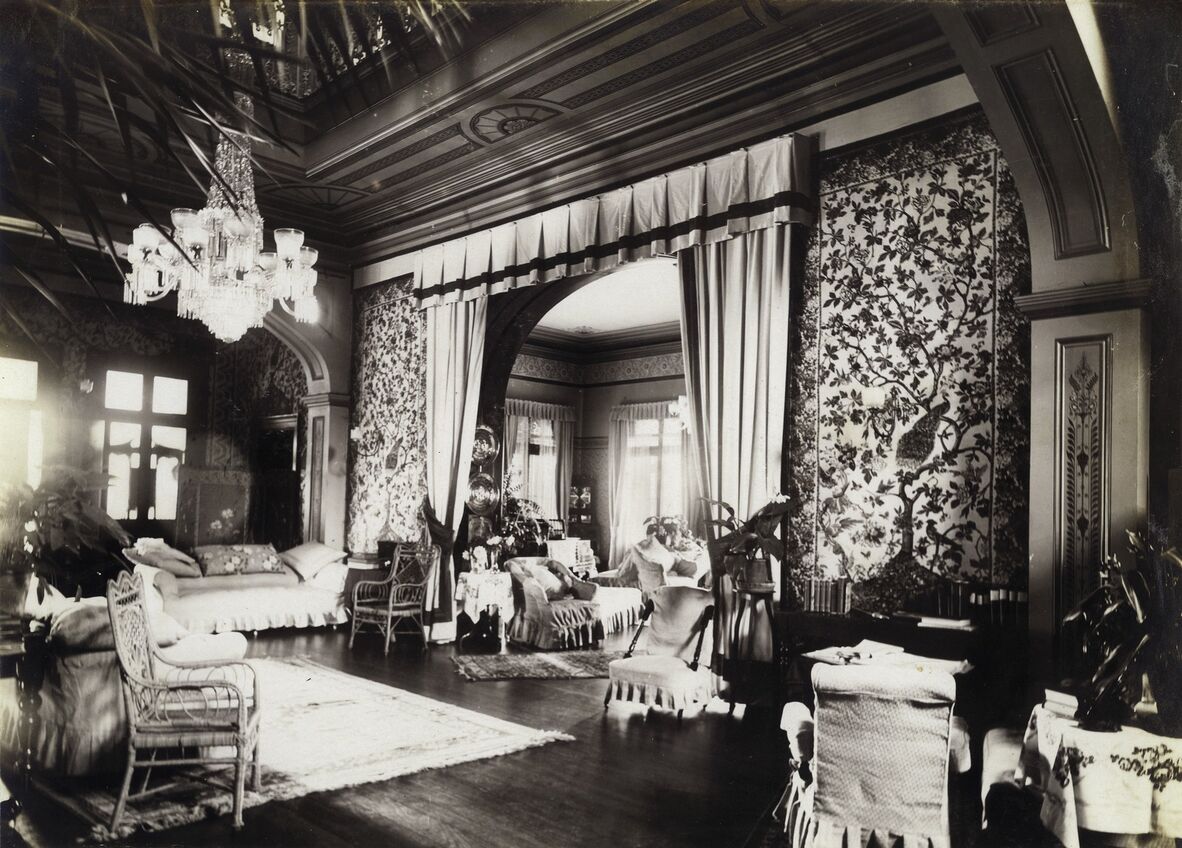
Looking through the hallway to the drawing room, Government House, Brisbane, October 1907. APO-28 Chelmsford Photograph Album. John Oxley Library, State Library of Queensland. Image number: APO-028-01-0006. (31)
Descriptions of colour may be found in newspaper articles, magazines, correspondence and diaries of former occupants. Catalogues, samples, advertisements and decorating guides from the era can also give an indication of available products and accepted principles for their selection and use in various rooms.
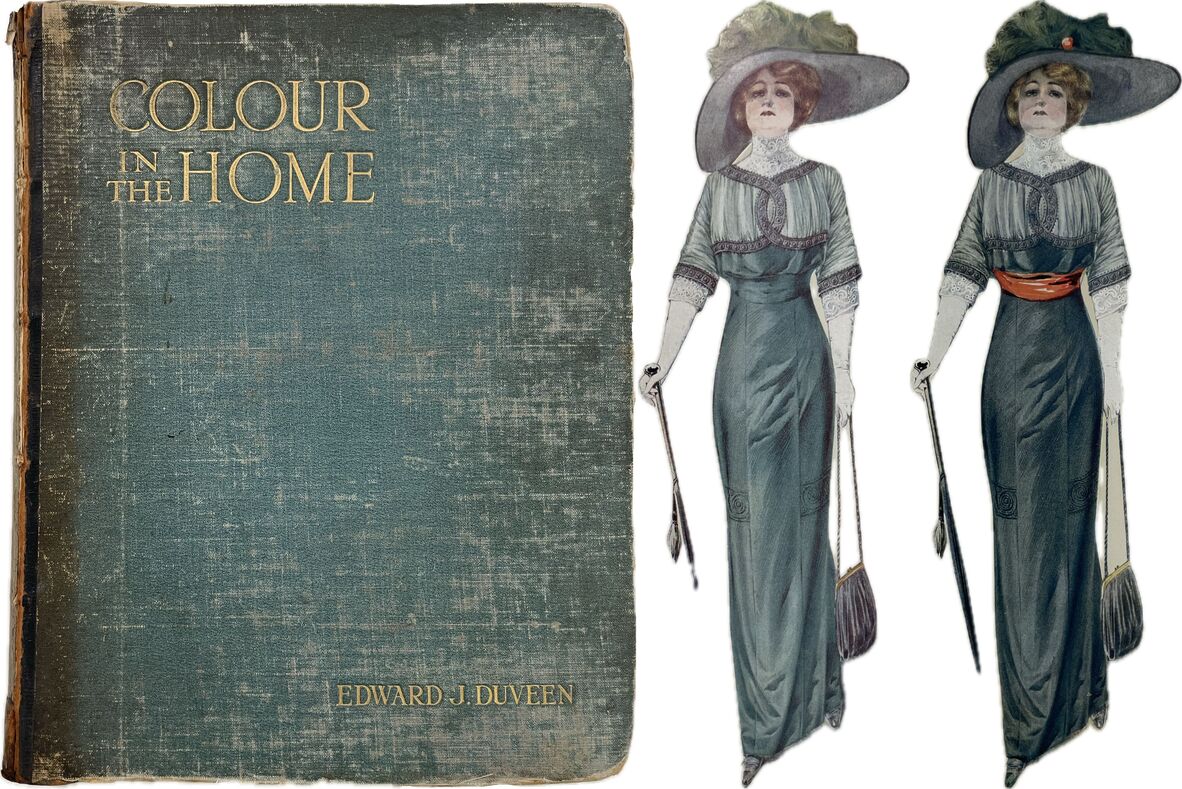
Cover and illustrations of good taste (left) and bad taste (right) in the use of colour, Colour in the home: with notes on architecture, sculpture, painting, and upon decoration and good taste, 1911. E.J. Duveen. John Oxley Library, State Library of Queensland. (32)
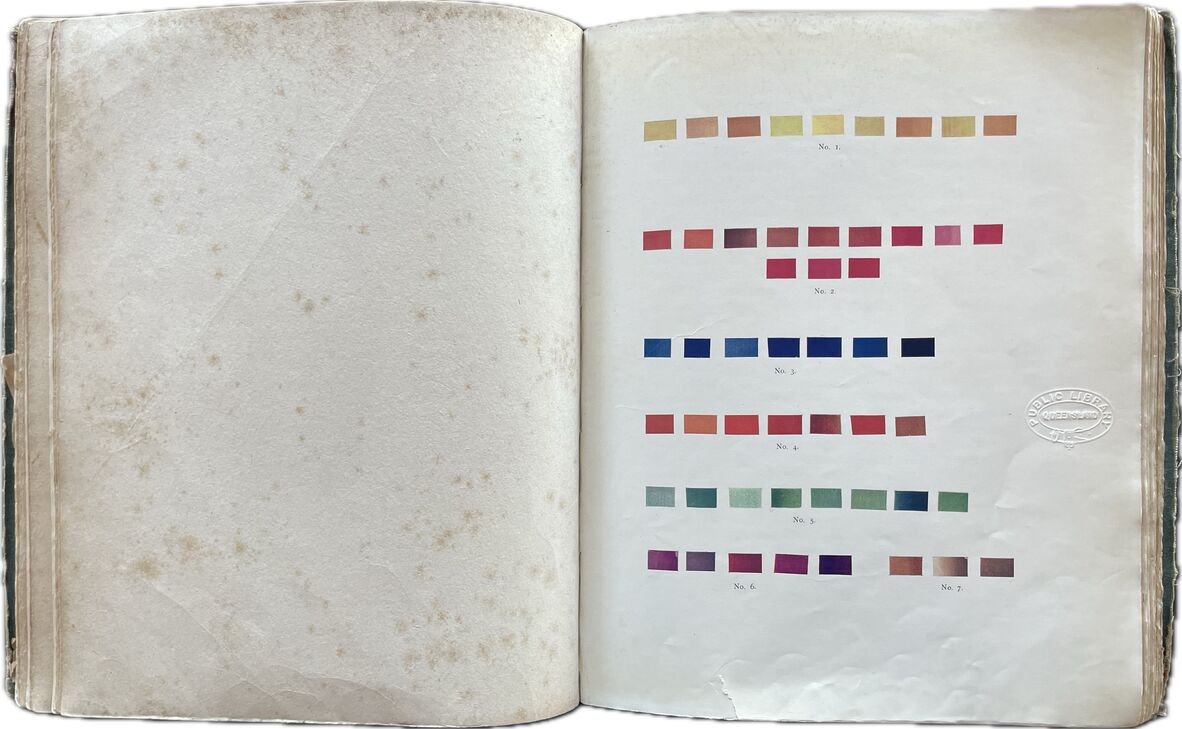
Illustration exploring harmony of colours. Colour in the home: with notes on architecture, sculpture, painting, and upon decoration and good taste, 1911. Edward J Duveen. John Oxley Library, State Library of Queensland. (32)
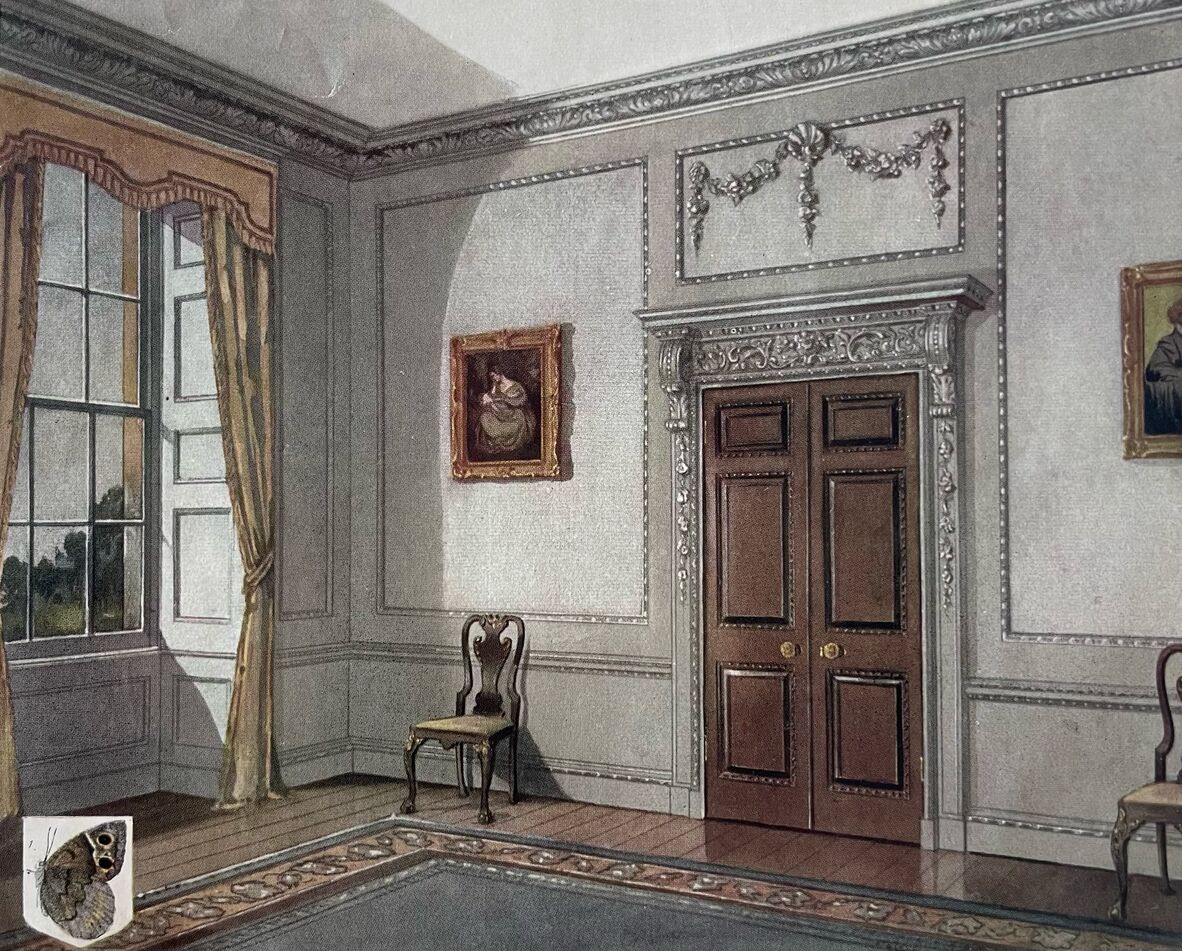
A morning room interior, showing scheme of colour adapted from a butterfly. Colour in the home: with notes on architecture, sculpture, painting, and upon decoration and good taste, 1911. Edward J Duveen. John Oxley Library, State Library of Queensland. (32)
Samples sourced from England and France by Elizabeth Byrne, the wife of the lighthouse keeper at Sandy Cape who decorated her home with colourful wallpaper, illustrate some of the products available to Queenslanders in the early 1900s. (33)
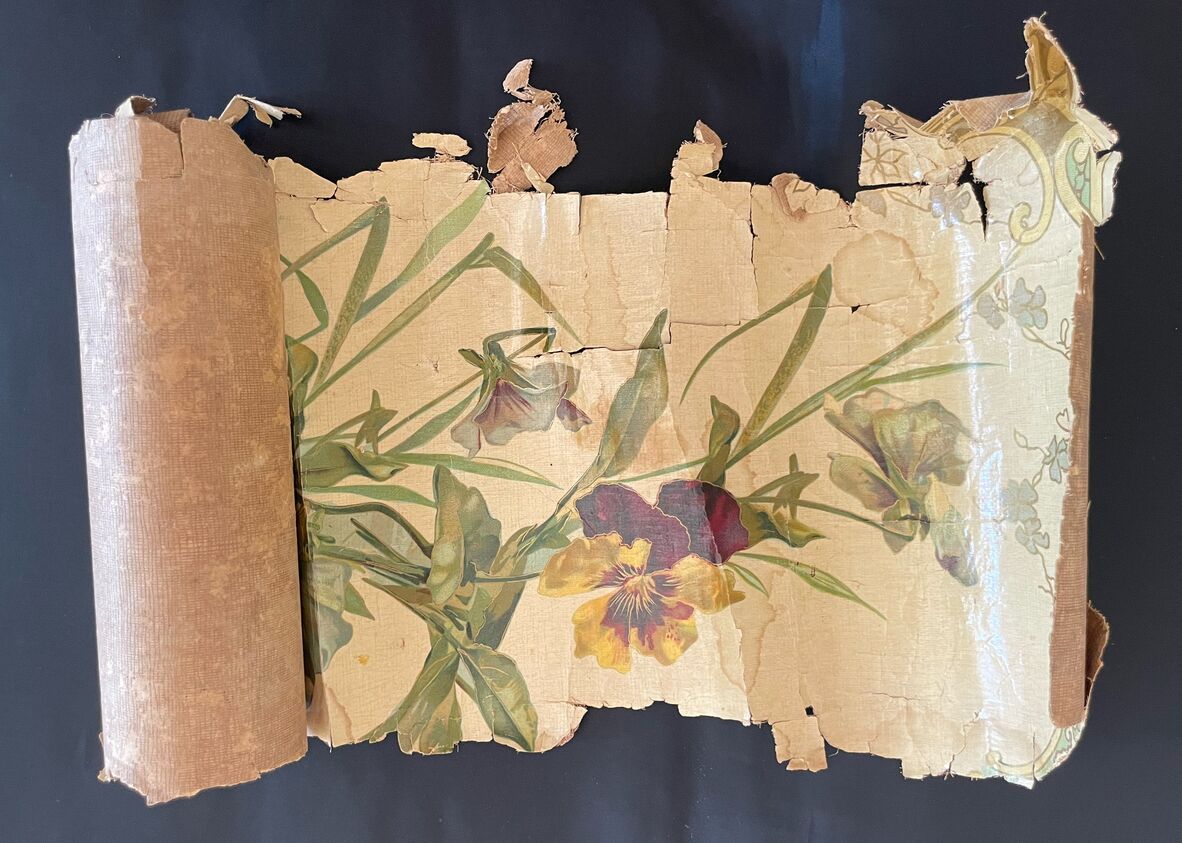
Wallpaper sample, ca. 1908-1910. 5475, Elizabeth Byrne Textiles. John Oxley Library, State Library of Queensland. (33)
In some instances, physical evidence of historical finishes survives in-situ, concealed behind later alterations and additions. These layers of interior archaeology can be carefully uncovered, recorded and analysed to reveal past decorative schemes and facilitate accurate reconstructions.
It is good practice to retain and conserve physical evidence of historical finishes in-situ, for future occupants to discover and appreciate first-hand. However, sometimes it is necessary to remove and conserve samples of historical finishes for archival purposes and for use as reference collections. These samples or ‘documents’ are a valuable resource for comparison when investigating historical interiors.
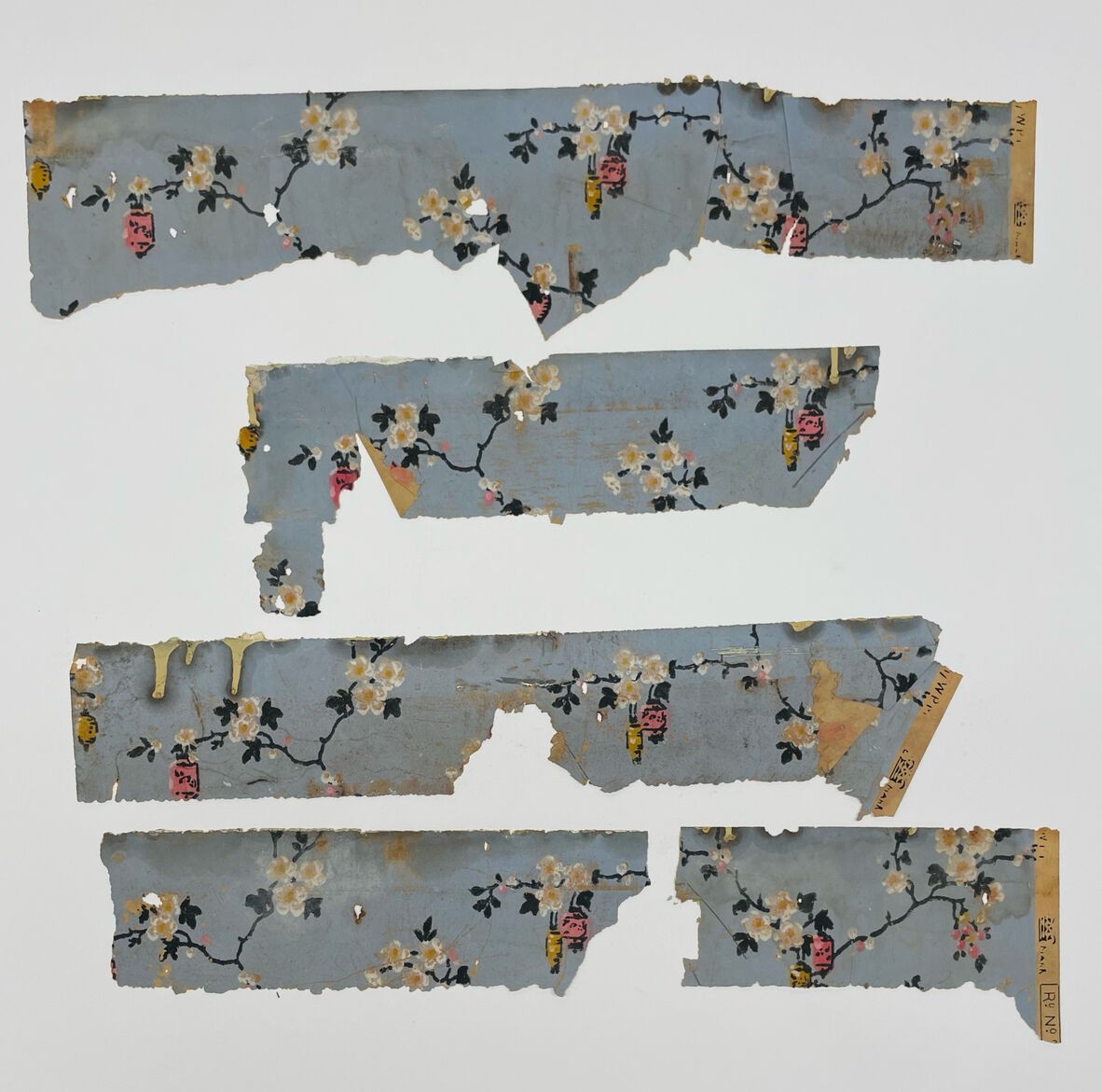
Wallpaper sample from Pringle Cottage, Warwick. Professional and business archive of Allom Lovell Architects. John Oxley Library, State Library of Queensland. Accession number 28652, Item 1576. (34)
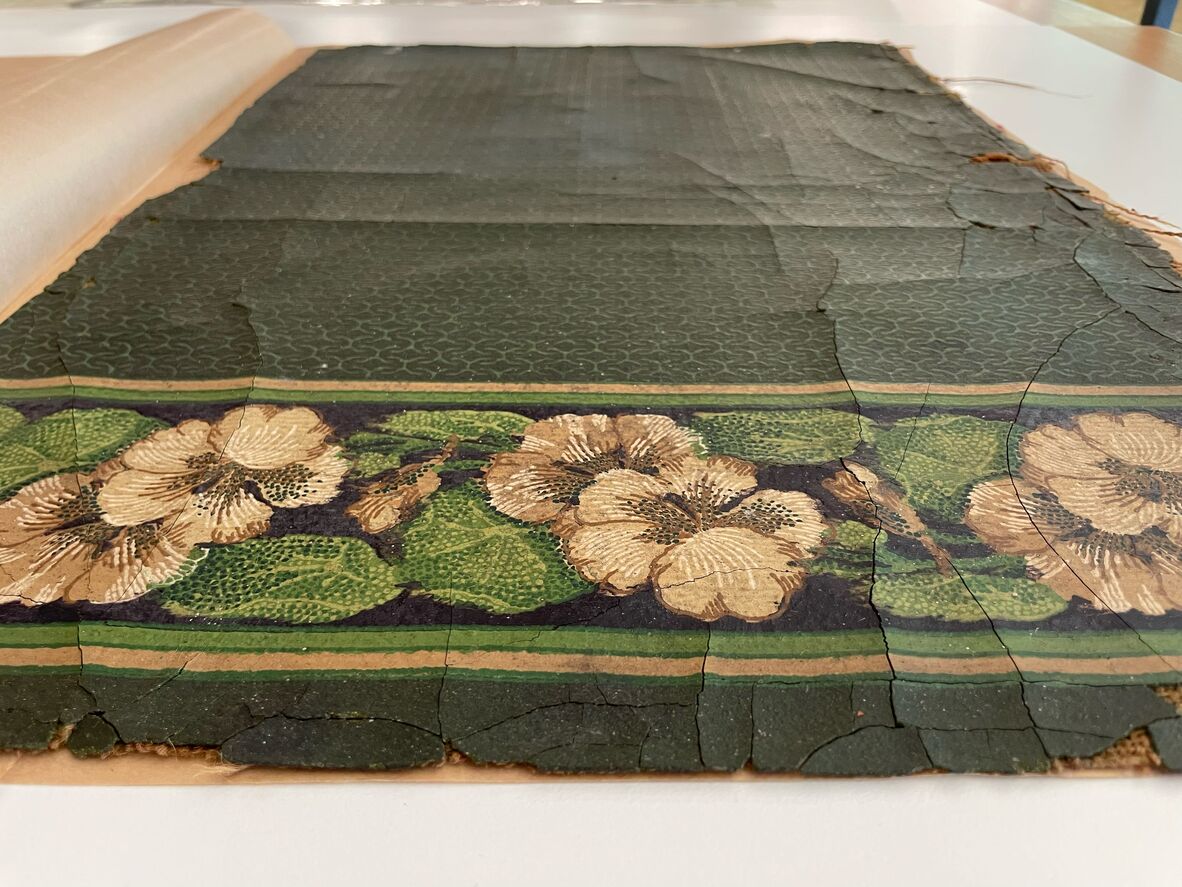
Linoleum sample from a House at Norman Park. Professional and business archive of Allom Lovell Architects. John Oxley Library, State Library of Queensland. Accession number 28652, Item 1577. (35)
Call out for your photographs!
If you have photographs or other materials that document these or other historical interiors in Queensland, please get in touch via qldmemory@slq.qld.gov.au.
Anna Rowe
2025 Digital Collections Catalyst
Read other blogs by Anna Rowe:
Read other blogs by past Digital Collections Catalysts.
References
- Anon (n.d.) Portrait of a group of ladies at a tea party, Charters Towers, ca. 1880-1890, John Oxley Library, State Library of Queensland. Negative number: 71744.
- Anon (n.d.) Intimate portrait of a man writing a letter, ca. 1900-1910, John Oxley Library, State Library of Queensland. Negative number: 175036.
- Wilson, M (n.d.) Eileen, Marjorie and Allan Row reading inside their home at the Dunwich Benevolent Asylum, ca. 1906-1914, 33383, Mark Wilson glass plate and photographic negatives collection, John Oxley Library, State Library of Queensland. Image number: 33383-0002-0091.
- Evans, I, Lucas, C & Stapleton, I (1983) Colour schemes for old Australian houses, Glebe, NSW, The Flannel Flower Press Pty Ltd; Forge, S (1981) Victorian splendour: Australian interior decoration 1837-1901, Melbourne, VIC, Oxford University Press; Lane, T & Serle, J (1990) Australians at home: a documentary history of Australian domestic interiors from 1788 to 1914, Melbourne, VIC, Oxford University Press.
- Aronson, FB (1900) XXth century cooking and home decoration, Sydney, NSW, William Brooks & Co; Bawden, G (2019) Comfort and judgment: nineteenth century advice manuals and the scripting of Australian identity, Clayton, VIC, Monash University Publishing; Duveen, EJ (1911) Colour in the home: with notes on architecture, sculpture, painting, and upon decoration and good taste, London, George Allen and Co Ltd; Rocke, WH & Co (1874) Remarks on Furniture and the Interior Decoration of Houses, Melbourne, VIC, WH Rocke & Co.
- Forge, S (1981), op. cit.
- Evans, I, Lucas, C & Stapleton, I (1983), op. cit.
- Aronson, FB (1900), op. cit., p.317.
- Evans, I & the National Trust of Queensland (2001) The Queensland house: history and conservation, Mullimbimby, NSW, The Flannel Flower Press Pty Ltd, p.109; Stairmand, N & Edwards, J (2000) Queensland interiors: a guide to their care – Number 2 Guidelines for conservation, Brisbane, QLD, the National Trust of Queensland.
- Stairmand, N & Edwards, J (2000) Queensland interiors: a guide to their care – Number 3 Paint schemes, Brisbane, QLD, the National Trust of Queensland.
- Evans, I & the National Trust of Queensland (2001), op. cit., p.109.
- Ibid., p.110.
- Anon (n.d.) Drawing room at Harrow, on the Darling Downs, ca. 1885, John Oxley Library, State Library of Queensland. Negative number: 16178.
- Anon (n.d.) Living room of the Poulsen family home, ca. 1910, John Oxley Library, State Library of Queensland. Negative number: 123083.
- Anon (n.d.) Interior view of the sitting room of a home in Clayfield, Brisbane, ca. 1915, John Oxley Library, State Library of Queensland. Negative number: 35265.
- Stairmand, N & Edwards, J (2000) Queensland interiors: a guide to their care – Number 1 Historic interiors, Brisbane, QLD, the National Trust of Queensland.
- Anon (n.d) Early example of interior decoration, Queensland, ca. 1885, John Oxley Library, State Library of Queensland. Negative number: 16176.
- Amos, OL (n.d.) Wallpaper is prominent in this drawing room, ca. 1888, GS-39 Owen Livingstone Amos Photograph Albums. John Oxley Library, State Library of Queensland. Negative number: 76362.
- Anon (1907) Drawing room at Government House, Brisbane, October 1907, APO-28 Chelmsford Photograph Album. John Oxley Library, State Library of Queensland. Image number: APO-028-01-0008.
- Allom, R & Campbell-Stewart, D (1978-2011) Professional and business archive of Allom Lovell Architects, John Oxley Library, State Library of Queensland. Accession number 28652, Items 1576 & 1577.
- Wunderlich Patent Ceiling & Roofing Co (1906) Beautiful Homes: a selection of photographs, illustrating the interiors of some Australian homes, Sydney, NSW, Wunderlich Patent Ceiling & Roofing Co. John Oxley Library, State Library of Queensland
- Stairmand, N & Edwards, J (2000) Queensland interiors: a guide to their care – Number 4 Floorcoverings, Brisbane, QLD, the National Trust of Queensland.
- Wheeler, AM (n.d.) Ornately decorated sitting room, date unknown, 30586 Mrs. Annie Margaret Wheeler papers 1884-1991. John Oxley Library, State Library of Queensland. Image number: 30586-0001-0042.
- Anon (n.d.) Photograph of the interior of Bobstay Cottage, Charters Towers, 1908, John Oxley Library, State Library of Queensland. Accession number: 33904.
- Evans, I & the National Trust of Queensland (2001), op. cit., p.109.
- Anon (n.d.) Interior view of a sitting room, Queensland, ca. 1895, John Oxley Library, State Library of Queensland. Negative number: 8710.
- Fegan, JW (n.d.) Interior of Mimosa, Hawthorne, ca. 1913, John Oxley Library, State Library of Queensland. Negative number: 62782.
- Anon (n.d.) Family portrait taken inside a tent, Mt. Garnet, North Queensland, ca. 1905, John Oxley Library, State Library of Queensland. Negative number: 13101.
- Graham, AD & Queensland Department of Agriculture (1905) Queensland at home, Brisbane, QLD, Powell & Co Printers.
- Anon (1909) Interior view of A.J. Moorhouse's dental surgery Queen Street, Brisbane, 1909, John Oxley Library, State Library of Queensland. Negative number: 120394.
- Anon (1907) Looking through the hallway to the drawing room, Government House, Brisbane, October 1907. APO-28 Chelmsford Photograph Album. John Oxley Library, State Library of Queensland. Image number: APO-028-01-0006.
- Duveen, EJ (1911), op. cit.
- Byrne, E (1908) 5475, Elizabeth Byrne Textiles ca. 1908 - Box 11168: Rolls of wallpaper, John Oxley Library, State Library of Queensland.
- Allom, R & Campbell-Stewart, D (1978-2011), op. cit.
- Ibid.
Watch this video to explore Anna's research project, and don’t miss the full video highlighting all the 2025 Queensland Memory Awards recipients and their inspiring projects.
Comments
Your email address will not be published.
We welcome relevant, respectful comments.